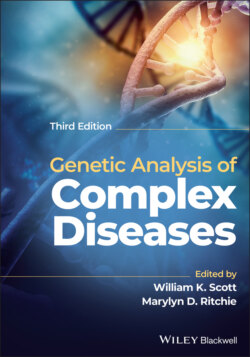Читать книгу Genetic Analysis of Complex Disease - Группа авторов - Страница 35
DNA, Genes, and Chromosomes Structure of DNA
ОглавлениеWhen Mendel described the unit of inheritance, he did not know the underlying biological factor. It was 90 years later when the actual genetic molecule was identified. The fundamental unit of inheritance that Mendel’s work uncovered was later termed “the gene.” A gene contains the information for synthesizing proteins necessary for human development, cellular and organ structure, and biological function. DNA is the molecule that comprises the gene and encodes information for synthesizing both proteins and ribonucleic acid (RNA). DNA is present in the nucleus of virtually every cell in the body. It is made up of three components: a sugar, a phosphate, and a base. In DNA, the sugar is deoxyribose, whereas in RNA, the sugar is ribose. The four bases in DNA are the pyrimidines adenine (A) and guanine (G) and the purines cytosine (C) and thymine (T). A DNA sequence is often described as an ordered list of bases, each represented by the first letter of its name (e.g. ACTGAAACTTGATT). A nucleoside is a molecule made of a base and a sugar; a nucleotide is made by adding a phosphate to a nucleoside.
A single strand of DNA is a polynucleotide, consisting of nucleotides bonded together. A single strand of DNA is, however, unstable. The double‐helical nature of DNA, which confers stability to the molecule, was hypothesized in 1953 by J. D. Watson and F. H.C. Crick. Their cohesive theory of the structure of DNA accounted for some of the previously identified properties of DNA (Watson and Crick 1953).
Figure 2.3 The DNA double helix is packaged and condensed in several different forms.
(Source: Reprinted by permission from Thompson et al. (1991).)
Specifically, Watson and Crick postulated that DNA is a double‐stranded structure and that the two strands of DNA are arranged in an antiparallel orientation (Watson 1968). In the central portion of the molecule, hydrogen bonds link a base with its complement, such that a purine always bonds with a pyrimidine (e.g. adenine always bonds with thymine and guanine always bonds with cytosine). The conformation of the resultant molecule is the double helix, which undergoes several levels of compacting to fit within the cell (Figure 2.3).
The sequence of DNA bases represents a code for synthesizing proteins. The fundamental unit of this genetic code is termed a codon, which consists of three nucleotides. Since there are four different nucleotides (one made with each of the four bases) and a codon is made of three nucleotides, there are 43, or 64, different codons. However, these 64 codons specify only 20 different amino acids, which are the building blocks of proteins. Thus, the genetic code is degenerated, meaning that different codons may code for the same amino acid (Figure 2.4). In addition, some codons act as punctuation. For instance, one specific codon signals the start for the reading of the DNA and several other codons signal the reading process to cease. These reading signals are called start and stop codons, respectively (see Figure 2.4).
While some of the DNA in a cell codes for a protein product, the vast majority of the DNA sequence does not carry information for the formation of a protein. Within a gene, exons are the portions utilized to make proteins. Introns are the sequences between exons that do not code for the final protein product. The size and number of introns and exons vary dramatically between genes.
The central dogma of genetics is that the utilization of DNA is unidirectional such that DNA → RNA → protein (Figure 2.5). Specifically, genes are encoded by the DNA. Then, in the nucleus, messenger RNA (mRNA) is transcribed (produced) through reading of the codons of DNA. The mRNA produced during transcription is a single‐stranded complement to the DNA but with the base uracil instead of thymine. Subsequently, mRNA undergoes a series of posttranscriptional modifications: The introns are spliced out, a cap is added at the 5′ end of the molecule, and a string of adenylate residues (poly‐A tail) is added to the 3′ end. The mRNA is then transported out of the nucleus into the cytoplasm, where it is translated into protein by means of cellular machinery called the ribosomes. Many excellent resources describe the very complicated process of transcription and translation (e.g. Strachan and Read 1996).
Figure 2.4 The genetic code and abbreviations for amino acids.
